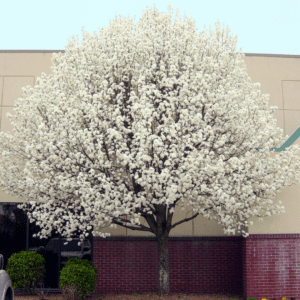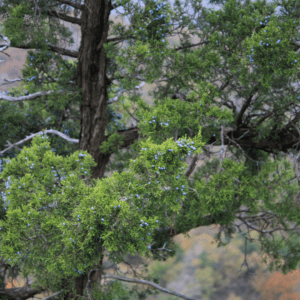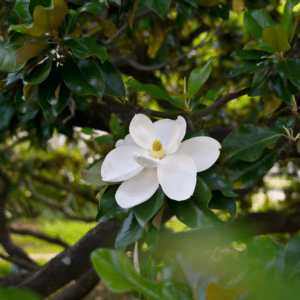Backyard Basics – How to Identify Native Trees in Your Backyard

Standing tall and stately among the southeastern savanna.
Reaching gnarled and spindly arms over the teaming swamplands.
Adorning the mountains and the piedmont with their bold colors.
And standing dependable and providential in your own backyard…
Trees.

Invasive bradford pear tree
These days, you can find much attention paid to non-native, invasive trees – such as the infamous Bradford pear (Pyrus calleryana). And rightly so! Invasive plant species are one of the largest threats facing wildlife and habitat – in North Carolina and beyond.
North Carolina Wildlife Federation is tackling this problem head-on through community based habitat restoration projects, many focused on removing invasive tree species and planting native alternatives. We also offer webinars and educational resources and programming to teach people how to identify invasive plant species in their own backyards and remove them.
But what about those native tree species that exist in your backyard? Native trees are essential for wildlife as they provide food, water, shelter and places for wildlife to raise young. They also contribute to the health of our communities by reducing pollution, regulating temperature, and improving water and air quality. How about an overview of how to identify native trees that you might just see right outside your window, just a step from your back door?
Backyard Basics – Identify Native Trees In Your Backyard
White and red oaks (Quercus alba and Quercus rubra) are deciduous trees in the beech family, Fagaceae. They are widespread throughout North Carolina and grow in a variety of soil types and topographic regions, often forming pure stands. Known to grow fairly quickly and to produce dense foliage and large trunks and branches, oaks are sought-after trees in the lumber industry and provide us with many of the wood products that we enjoy on an everyday basis.

White oak (left) and red oak in fall colors (right)
The oak’s fruit is an easily noticeable acorn or nut that can grow singularly or in clusters, and is encased in a bark-like cap that is attached to the branch. When mature, the acorns turn a dark brown and become ripe in the late summer and early fall and – in addition to the leaves – provide an essential food source to many species of wildlife.
Oaks provide habitat and protection to many types of wildlife, including cavity-nesting birds such as owls, woodpeckers, chickadees, bluebirds, flycatchers, and tufted titmice, along with flying squirrels, bats, and other mammals. Dropped limbs and fallen trunks decompose with the help of microbes, fungi, and invertebrates, which, in turn, attract animals that feed upon them, including other invertebrates, salamanders, skinks, and snakes.
“Caterpillars are the mainstay of most bird diets in North America,” writes Douglas W. Tallamy in his book Nature’s Best Hope, “particularly when birds are rearing their young.” Tallamy and his colleague Kimberley Shropshire documented that across the U.S., oaks host the greatest caterpillar diversity: At least 934 caterpillar species were supported by oaks, 557 of these in the Mid-Atlantic region, with many of these on the Eastern White Oak. A single large tree can host thousands of individual caterpillars (Tallamy, 2020).
Though very similar in many ways, white and red oaks can be easily distinguished from one another by the shape of their leaves. Red oaks boast a series of pointed tips along the leaf’s outer edge, while white oak leaf tips are rounded.
American holly (Ilex opaca), is an evergreen tree that is native to the central and eastern regions of North America. It commonly grows in woods or along stream and river banks.

American holly
American hollies are often planted in urban settings due to their tolerance for pollution.
In the spring and early summer, the American holly produces small greenish-white flowers that ripen into red berries in fall and winter. A male and female plant must be in close range to one another in order to produce the berries that will ripen on the female plant and persist on the tree through the winter.
When flowering, American holly provides nectar for pollinators such as bees and butterflies. It is also the larval host plant for Henry’s Elfin butterfly larvae which appear from February to May. The fruits are eaten by songbirds, wild turkeys, quail, white-tailed deer, squirrels and other small mammals. These berries are not edible for humans.
Eastern red cedar (Juniperus virginiana), is an evergreen tree that is native to the eastern half of North America. Its name is a little misleading, since it is in fact a juniper, not a cedar.

Eastern cedar
It grows in a variety of habitats including pastures, prairies and woodland edges.
The red cedar’s notable feature is its ability to tolerate very tough garden conditions. Whether your yard experiences extreme heat and drought or prolonged freezing temperatures, eastern red cedar will remain steadfast.
Many birds and mammals eat the pale blue berries, including the cedar waxwing. Many insects rely on eastern red cedar as well, such as the juniper hairstreak, for which the eastern red cedar is a larval host plant.
Flowering dogwood (Cornus florida), is a deciduous tree native across the eastern and central United States, southeastern Canada, and eastern Mexico. This dogwood is an understory tree, commonly found in moist woods, slopes, and forest or woodland edges. It can be grown in all three major eco-regions of North Carolina. Loved by many, the flowering dogwood is also North Carolina’s state flower.

Flowering dogwood
Flowering dogwood has a small stature, typically growing 15 to 25 feet tall and occasionally over 30 feet. It has a pyramidal growth habit and often appears flat-topped or layered.
The flowers provide excellent pollen and nectar to early-emerging pollinators. Once pollinated, red fruits develop in clusters that are readily foraged by turkey, squirrels, foxes, black bears, birds, and other wildlife.
These leaves often host a multitude of insects, including the spring azure butterfly.
Persimmon (Diospyros virginiana), is a deciduous tree that is native to the eastern half of North America. It is commonly found in full sun or partial shade conditions in open prairies, pine forests, dry woodlands or old fields.

Persimmon
The bell-shaped flowers are creamy or light green in color and appear along the branches in the spring. Persimmons are mainly pollinated by bees but other pollinators may stop for a visit as well. Luna moth and hickory horned devil caterpillars may be found munching on the leaves.
The fruit ripens in the fall and will remain on the tree into the winter, allowing a window of time for the beautiful pinkish-orange fruit to display on bare branches. Persimmon fruits are 1-2 inches in size and have a sweet taste. Birds, deer, foxes, and other wildlife eat persimmons once they are ripe.
Persimmon fruit is often used to make jellies, ice cream, and pies once it is ripe. The under-ripe fruit is acidic with a very bitter taste.
Possumhaw (Ilex decidua), is a deciduous holly native to eastern North America. It can be found naturally growing in wet woods, along streams, and in lowland valleys and swamps.

Possumhaw
In spring, butterflies and other pollinators visit the small, cream-colored blooms for nectar and pollen. The leaves are glossy, green and oval-shaped, giving possumhaw a beautiful summer texture. Berries form on the female plant and begin to ripen in September, persisting on bare branches late into the winter. In order for possumhaw to produce berries, a female and male plant must be planted in close proximity for cross pollination.
Possumhaw offers a lot for wildlife. Not only do the flowers support pollinators, but it serves as the host plant for the Henry elfin butterfly. The fruits are eaten by songbirds, game birds and mammals such as opossums and raccoons. In addition to serving as a food source, some species also rely on possumhaw for cover or nesting sites.
Redbud (Cercis canadensis), is a small to medium sized deciduous tree that is native to eastern and central North America. It is often found as an understory tree on hillsides, fields and streambanks.

Redbud
Redbuds typically grow 15 to 30 feet high but they are relatively slow growing.
From March to May, bright pink or purple flowers burst into bloom along its branches, well before the tree leafs out. The abundance of the small, pea-like flowers attracts a variety of native bees and other pollinators. The heart-shaped leaves are bright green in the summer, turning a yellowish-gold color in the fall before dropping off the tree. Redbuds are in the legume family, so pollinated flowers develop into a flattened seedpod that drops from the branches.
Redbud has a long list of wildlife benefits. Not only does it provide cover, but songbirds and small mammals will occasionally eat the seeds. It is the host plant for as many as 12 species of Lepidoptera, including the white-marked tussock moth and Henry’s elfin butterfly. Pollinators flock to the trees’ floral resources, while leaf-cutter bees and other insects harvest pieces of the leaves to incorporate into their nests.
Redbuds have nitrogen fixing properties that enrich garden soils.
Red maple (Acer rubrum), is a native, deciduous tree that grows in central and eastern North America. It naturally grows in upland deciduous forests and along stream banks in eastern and central North America.

Red maple boasting summer and fall colors
Red maples can grow anywhere from 40 to 70 feet high, making them a great shade tree for lawns, streets and parks. The red maple can be found growing in all three regions of North Carolina, and is frequently planted in urban areas because of its tolerance of compacted soils, air pollution and heat.
The blooms appear in late winter or early spring and develop in drooping clusters. The flowers are bright red to pinkish-orange with stamens protruding from the flowers. The flowers are pollinated by both wind and early emerging bees. Once pollinated, the flowers develop into brown or red samaras that drop in late spring and summer.
Not only is red maple beautiful year-round, but it also provides lots of wildlife opportunities. Red maple flowers are one of the earliest nectar sources for bees and it is the host plant for numerous insects. The seeds are foraged by birds and squirrels, while new growth may be browsed by deer and other mammals.
Southern magnolia (Magnolia grandiflora), is a large evergreen tree that is native to the eastern half of the United States. Its reach spans

Magnolia
from Maryland south to Florida and west to Texas where it can be found naturally growing as an understory tree in moist forests and woodlands.
Its flowers are large, fragrant and develop all over the tree. It will attract many pollinators to your landscape. Once pollinated, it produces cones of clustered bright red, fleshy fruits that are foraged by birds and mammals. Its broad, evergreen leaves are dark green, glossy and leathery to the touch. They provide excellent cover for birds and other wildlife during the winter.
Winged sumac (Rhus copallinum), is a native, deciduous small tree (or large shrub) that can be found in central and eastern regions of

Winged sumac
North America. It can be found naturally occurring in plains, rocky slopes, woodlands and prairies. As it grows, it tends to sucker and create a dense patch of habitat that is perfect for hillsides and natural areas.
Winged sumac blooms in the late summer, typically from July to September. The greenish-yellow flowers develop into a bushy panicle of star-shaped flowers that grow at the center of the outward branches. This cluster of nectar and pollen attracts an abundance of pollinators. The compound, green leaves turn a bright red in the fall adding beautiful fall color to a garden.
The berries are eaten by songbirds, gamebirds, and mammals. It is also the larval host plant for red-banded hairstreaks and luna moths.

– Written by Bates Whitaker, NCWF Communications & Marketing Manager

